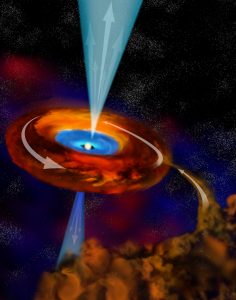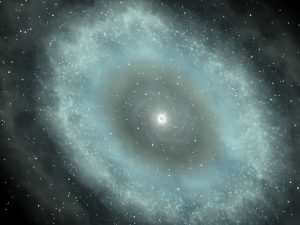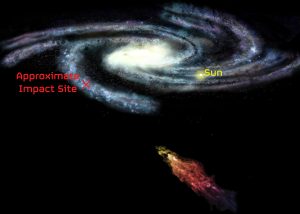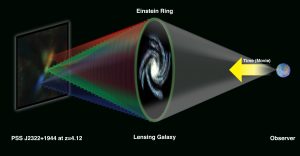In this artist’s interpretation, a massive young star draws matter around it, so much so that its magnetic field is overwhelmed with charged particles that are shot outward as jets from its poles.


A Disk of Starforming Gas
Artist’s conception of the disk of star-forming gas around the center of the galaxy hosting the quasar PSS J2322+1944. The disk is about 13,000 light-years in diameter. The luminous quasar, powered by the infall of matter into a supermassive black hole, is at the center.

Smith’s Cloud on Its Way to the Milky Way
A giant cloud of hydrogen gas is speeding toward a collision with our Milky Way Galaxy, and when it hits — in less than 40 million years — it may set off a spectacular burst of stellar fireworks. The cloud, called Smith’s Cloud, after the astronomer who discovered it in 1963, contains enough hydrogen to make a million stars like the Sun. Eleven thousand light-years long and 2,500 light-years wide, it is only 8,000 light-years from our Galaxy’s disk. It is careening toward our Galaxy at more than 150 miles per second, aimed to strike the Milky Way’s disk at an angle of about 45 degrees. Don’t worry! It will hit 30,000 light years away from Earth.

Model of a Black Hole
Deep inside the monster galaxy M87 is a supermassive black hole. In this artist’s model, the black hole is the tiny dot in the center of a whirling disk of heated gas. Strong magnetic fields surround the disk and the north and south poles of the field act like railroad track to spiral charged particles outward.

Galactic Bridge
An artist’s impression of the enormous bridge of hydrogen that spans the space between our neighboring galaxies Andromeda and Triangulum. The bridge was discovered using the Robert C. Byrd Green Bank Telescope (GBT) in West Virginia.

What is a Lensed Galaxy?
The Very Large Array (VLA) looked at a galaxy more than 12 billion light-years from Earth. Between this galaxy and Earth lies another distant galaxy, so perfectly aligned along the line of sight that its gravity bends the light and radio waves from the farther object into a circle, or “Einstein Ring.” Gravitational lenses were predicted, based on Albert Einstein’s General Theory of Relativity, in 1919. Einstein himself showed in 1936 that a perfectly-aligned gravitational lens would produce a circular image, but felt that the chances of actually observing such an object were nearly zero. The first gravitational lens was discovered in 1979, and the first Einstein Ring was discovered by researchers using the VLA in 1987.





